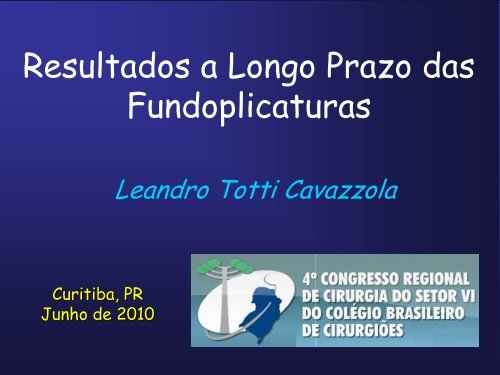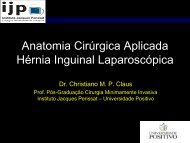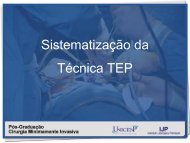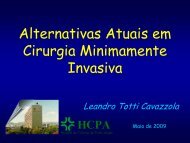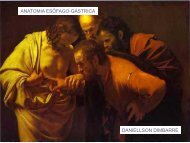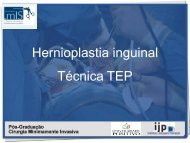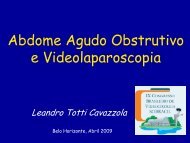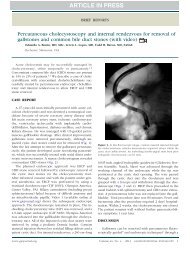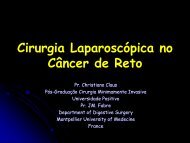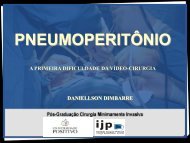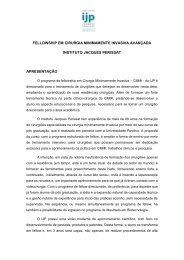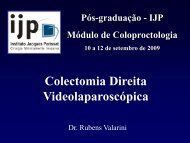Resultados Fundoplicatura a Longo Prazo - IJP
Resultados Fundoplicatura a Longo Prazo - IJP
Resultados Fundoplicatura a Longo Prazo - IJP
Create successful ePaper yourself
Turn your PDF publications into a flip-book with our unique Google optimized e-Paper software.
<strong>Resultados</strong> a <strong>Longo</strong> <strong>Prazo</strong> das<br />
<strong>Fundoplicatura</strong>s<br />
Leandro Totti Cavazzola<br />
Curitiba, PR<br />
Junho de 2010
O que é dor crônica ?<br />
IASP. Pain 1999; 83: 91-5<br />
Ferzli GS. J Am Coll Surg 2007; 205: 333-41
Qual a dimensão do problema ?<br />
- Normalmente subestimada pelos cirurgiões<br />
- Incidência real é desconhecida<br />
- pctes com sintomas leves não vão ao cirurgião<br />
- poucos são referenciados para quem operou<br />
- especialistas de dor ?<br />
O’Dweyr PJ. Ann Surg 2006; 244(2): 167-73
Qual a dimensão do problema ?<br />
- 30% pctes cirurgia aberta desconforto aos 24-36m<br />
- 6% dor incapacitante<br />
Franneby U. Ann Surg 2006; 244(2): 212-9<br />
Kalliomäki ML . Acta Anaesthesiol Scand. 2009; 53(2):236-46
Considerações Gerais<br />
- Reparos sem tensão modificaram estudo HI<br />
- Causa + comum: lesão nervosa dissecção inadequada<br />
O’Dweyr PJ. Ann Surg 2006; 244(2): 167-73<br />
Schäfer M. World J Surg. 2010; 34(4):697-8.
Guy de<br />
Chauliac<br />
(1300-1368)<br />
“A blind man works on wood the same way as<br />
a surgeon on the body, when he’s ignorant of<br />
anatomy.”
Importância da Anatomia<br />
- Dissecção adequada e cuidado 5 nervos:<br />
complicações<br />
↑ qualidade de vida<br />
Rab M. Plast Reconst Surg 2001; 108 (6): 1618-23<br />
O’Dweyr PJ. Ann Surg 2006; 244(2): 167-73<br />
Ferzli GS, Surg Clin North Am 2008; 88: 203-16<br />
Schäfer M. World J Surg. 2010; 34(4):697-8.<br />
Smeds S. Hernia. 2010 Feb 10. [Epub ahead of print]
Importância da Anatomia<br />
- Problemas:<br />
- apenas 20% tem distribuição “normal”<br />
- apenas 40% distribuição é simétrica<br />
- existe comunicação direta entre ramos<br />
Rab M. Plast Reconst Surg 2001; 108 (6): 1618-23<br />
O’Dweyr PJ. Ann Surg 2006; 244(2): 167-73<br />
Ferzli GS, Surg Clin North Am 2008; 88: 203-16<br />
Schäfer M. World J Surg. 2010; 34(4):697-8.<br />
Smeds S. Hernia. 2010 Feb 10. [Epub ahead of print]
Diferenças entre<br />
Cirurgia Aberta e<br />
Cirurgia Endoscópica<br />
Ferzli GS, Surg Clin North Am 2008; 88: 203-16<br />
Langeveld HR. Ann Surg. 2010; 251(5):819-24
Importância da Anatomia<br />
- Quando identifica 3 nervos, não há relato de dor PO<br />
- Quando lesa 3 nervos, 40% dor crônica<br />
Alfieri S. Ann Surg 2006; 243(4): 553-8
Fatores de Risco<br />
- Dor severa no pré-operatório<br />
- lesão nervosa prévia<br />
- limiar para dor<br />
- Presença de complicações pós-operatórias<br />
- hematoma<br />
- infecção FO<br />
- Lesão direta do nervo<br />
- neuroma<br />
- Papel da tela<br />
- degeneração mielina edema fibrose<br />
- associação<br />
Demirer S. J Surg Res 2006; 131(2): 175-81<br />
Franneby U. Ann Surg 2006; 244(2): 212-9<br />
Ferzli GS, Surg Clin North Am 2008; 88: 203-16
Uso de Tela<br />
- Ia, A<br />
- Tela risco recorrência<br />
- Não interessa maneira de colocação<br />
- dor<br />
EU Hernia Trialists Colaboration. Ann Surg 2002; 235; 322-32
- Ia, B<br />
- Procedimentos endoscópicos x Lichtenstein x PHS<br />
- dor nos procedimentos endoscópicos<br />
Nienhuijs S, Staal E, Strobbe L, et al. Am J Surg 2007; 194: 394-400.
Takata MC, Duh QY. Surg Clin North Am 2008; 88: 157-178
Evitando a dor ...<br />
- Conhecimento preciso da anatomia<br />
- Preservação dos nervos<br />
- Cuidados técnicos - NÃO REALIZAR !!!!<br />
- suturas na inserção medial do LI<br />
- divisão extensa subcutâneo<br />
- remoção cremáster<br />
- dissecção extensa íleoinguinal<br />
- fechamento excessivo AIP<br />
- suturas na borda inferior OI<br />
Ferzli GS, Surg Clin North Am 2008; 88: 203-16
Tipos de Trauma aos Nervos<br />
- Transecção completa ou parcial<br />
- Tensão (stretching)<br />
- Contusão<br />
- Pinçamento<br />
- Lesão Térmica<br />
- Compressão pela sutura ou tela<br />
Ferzli GS, Surg Clin North Am 2008; 88: 203-16
Neurectomia Profilática ???<br />
- Transecção útil em alguns casos<br />
- 6-7% parestesia/anestesia em 1 ano<br />
- Extremamente controverso na literatura<br />
- Maior parte dos autores não recomenda<br />
Tsakayannis DE. Hernia 2004; 8(1): 67-9<br />
Pappalardo G. WJS 2007l 31: 1081-6<br />
Wijsmuller AR. Br J Surg. 2007;94(1):17-22.<br />
Smeds S. Hernia. 2010 Feb 10. [Epub ahead of print]
Tipos de Dor<br />
- Não Neuropática<br />
Recidiva herniária<br />
Cicatrização hipertrófica<br />
Pressão da tela<br />
Ferzli GS, Surg Clin North Am 2008; 88: 203-16
Tipos de Dor<br />
- Neuropática<br />
Aprisionamento suturas/stappler<br />
Formação neuroma/transecção<br />
total ou parcial<br />
Ferzli GS, Surg Clin North Am 2008; 88: 203-16
Avaliação<br />
- Equipe multidisciplinar é fundamental<br />
- Excluir causa não neuropática<br />
- Avaliação clínica completa – ênfase dermátomos<br />
- Realização de exames complementares<br />
- imagem Eco X TC X RNM<br />
- eletroneuromiografia<br />
Ferzli GS, Surg Clin North Am 2008; 88: 203-16
Tratamento<br />
- Inicialmente conservador para todos os casos<br />
- Subgrupo de pacientes terá dor severa<br />
- Não perder tempo quando sintomas persistirem<br />
- Não há tratamento ideal<br />
Ferzli GS, Surg Clin North Am 2008; 88: 203-16<br />
Langeveld HR. Ann Surg. 2010; 251(5):819-24<br />
Bright E. WJS 2010 ; 34(4):692-6
Tratamento Conservador<br />
- Analgésicos VO<br />
- Bloqueio regional – colabora no diagnóstico<br />
- Acupuntura<br />
- Antidepressivos tricíclicos<br />
- Gabapentina<br />
- Radiofrequência<br />
- Percentual importante não melhora com tto clínico<br />
Ferzli GS, Surg Clin North Am 2008; 88: 203-16<br />
Langeveld HR. Ann Surg. 2010; 251(5):819-24<br />
Bright E. WJS 2010 ; 34(4):692-6
Tratamento Cirúrgico<br />
- Quem precisa do tto ?<br />
- Cirurgia pode piorar sintomas<br />
- Indicação formal – sintomas persistentes 6m a 1 ano<br />
Ferzli GS, Surg Clin North Am 2008; 88: 203-16<br />
Aasvang EK. Ann Surg. 2009;249(2):327-34<br />
Langeveld HR. Ann Surg. 2010; 251(5):819-24<br />
Bright E. WJS 2010 ; 34(4):692-6
Tratamento Cirúrgico<br />
- Identificação e ressecção neuromas 80% sucesso<br />
- Cirurgia laparoscópica<br />
- retirada dos grampos por VLP<br />
- tecnicamente difícil<br />
Ferzli GS, Surg Clin North Am 2008; 88: 203-16<br />
Aasvang EK. Ann Surg. 2009;249(2):327-34<br />
Langeveld HR. Ann Surg. 2010; 251(5):819-24<br />
Bright E. WJS 2010 ; 34(4):692-6
Tratamento Cirúrgico<br />
- Não há tratamento ideal !!!!!!!!!!!!<br />
- Melhor abordagem: re-exploração aberta<br />
remoção da tela<br />
ressecção nervos<br />
- Neurectomia tripla ?<br />
Rosen MJ. Hernia. 2006 Mar;10(1):20-4<br />
Ferzli GS, Surg Clin North Am 2008; 88: 203-16<br />
Aasvang EK. Ann Surg. 2009;249(2):327-34<br />
Langeveld HR. Ann Surg. 2010; 251(5):819-24<br />
Bright E. WJS 2010 ; 34(4):692-6
Tratamento Cirúrgico<br />
- Lichtenstein e Amid – Neurectomia tripla<br />
- 68-80% pacientes melhoram da dor<br />
Amid PK. Hernia. 2004; 8(4):343-9<br />
Hernia Update 2010, Orlando 17-20<br />
Rosen MJ. Hernia. 2006;10(1):20-4<br />
Ferzli GS, Surg Clin North Am 2008; 88: 203-16<br />
Aasvang EK. Ann Surg. 2009;249(2):327-34<br />
Langeveld HR. Ann Surg. 2010; 251(5):819-24<br />
Bright E. WJS 2010 ; 34(4):692-6
Avaliação e Tratamento<br />
Ferzli GS. J Am Coll Surg 2007; 205: 333-41
Prevenção
Historical Aspect<br />
• Rudolf Nissen ( 1896-1981)<br />
• Thoracic surgery- lobectomy and pneumonectomy<br />
• Professor of Surgery in Istanbul, Turkey 1933<br />
• Mid 1930s: began work that would lead to his 1 st performed fundoplication in 1955<br />
• 1956 Swiss journal, Schweizerische Medizinische Wochenschrift<br />
• Brooklyn Jewish Hospital and Maimonides Hospital 1941<br />
• Chairman of Surgery at the University of Basel, Switzerland 1951
Gastroesophageal reflux disease<br />
• MC GI disorder of the western world.<br />
• 44% adults in US have abnormal reflux of acidic<br />
gastric juices into the esophagus on a montly<br />
basis.<br />
• 10% of patients require daily acid suppression<br />
medication<br />
• Over 1.0 million out patients visit per year
* Restrospective analysis<br />
* Medical or surgical treatment for > 1 yr<br />
* 120 pts undergoing surgery<br />
* 51 pts nonoperative mgt<br />
* QOL: surgery > medical
Complete vs. partial fundoplication<br />
• Ant. partial fundoplication<br />
Thal/Dor procedure<br />
• Post. partial fundoplication<br />
Toupet procedure
Barrett
Causes of Refractory GERD<br />
Patient Related Factors<br />
Compliance<br />
Motility Disorder<br />
Eosinophilic Esophagitis<br />
Hypersensitive Esophagitis<br />
Non-Acidic Reflux<br />
Psychological Comorbidity<br />
Therapy Related Factors<br />
Eradification of Helicobacter<br />
Pylori infection<br />
Nocturnal Acid Breakthrough<br />
(NAB)<br />
Resistance to PPI<br />
Rapid Metabolism of PPIs
EsophyX (FDA approved)<br />
Pre-op Post-op After 4 weeks
Medigus (not FDA approved)
Seven-year follow-up of a randomized clinical trial<br />
comparing proton-pump inhibition with surgical<br />
therapy for reflux esophagitis.<br />
Lundell et al, Br J Surg. 2007 Feb;94(2):198-203<br />
Cumulative proportion of patients staying in remission over the 7 years<br />
after randomization to antireflux surgery or continuous omeprazole<br />
therapy. Patients maintained on 20 mg omeprazole
Seven-year follow-up of a randomized clinical trial<br />
comparing proton-pump inhibition with surgical<br />
therapy for reflux esophagitis.<br />
Lundell et al, Br J Surg. 2007 Feb;94(2):198-203<br />
Cumulative proportion of patients staying in remission over the 7<br />
years after randomization to antireflux surgery or continuous<br />
omeprazole therapy. Inclusion of patients who relapsed on the initial<br />
dose and had a dose adjustment to 40 or 60 mg omeprazole.
cavazzola<br />
gmail.com


